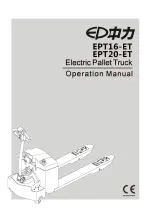
STEERING 9-15
REMOVAL
1. Remove clam p yoke and adjuster plug as previously
outlined.
2. Remove valve assembly by grasping stub shaft and
pulling straight out. N O T E : It m ay be necessary to
use pliers to aid in removal. Use care not to dam age
stub shaft splines (fig. 9).
DISASSEMBLY
Key num bers in text refer to figure 2.
1. Remove spool spring (13) by prying on small coil with
a small screwdriver. D O N O T pry against the valve
body as this m ay result in a sticky valve. W ork spring
onto bearing diam eter of stub shaft (20); then slide
spring off shaft.
2. Using extrem e caution, rem ove the valve spool (15) as
follows:
The diam etral clearance between valve and valve spool
(15) m ay be as low as 0.0004 inch. T he slightest “ cock
ing" of spool m ay jam it in valve body. To remove the
valve spool, hold the valve assembly in both hands with
stub shaft (20) pointing down and tap stub shaft gently
against wood block. It m ay be necessary to push lightly
on valve spool with a pencil or small brass rod inserted
through openings in valve cap until the spool can be
grasped by hand (fig. 10). W ithdraw spool with a steady
oscillating pull to prevent jam m ing (fig. 11). If slight
sticking occurs, m ake a gentle attem pt to reverse the
withdrawal procedure. If this does not free spool, it has
become “cocked” in the valve body bore. Do not attem pt
to force spool in or out of valve body. If such is the case,
continue to disassemble the valve assembly as follows and
return to the spool as described later.
3. Rem ove the stub shaft, torsion bar, and valve cap as
sembly (20) by holding the valve assembly in both hands
with thum bs on the valve body. T ap torsion bar lightly
against w ork bench. This will dislodge the cap from the
valve body to cap pin. The stub shaft, torsion bar, and
valve cap assem bly can then be removed from the valve
body (18).
4. If the valve spool (15) has becom e “ cocked” as des
cribed in step 2 above, it can now be freed. By visual in
spection on a flat surface, it can be determ ined in which
direction spool is “ cocked.” A very few light taps with a
light, soft plastic or rawhide m allet should align the spool
in bore and free it.
IMPORTANT: Do not tap the spool with any
thing metallic. If spool can be rotated, it can be
removed.
5. Remove valve spool dam pen er O-ring seal (14) from
spool and discard.
6. Do not remove the control valve (Teflon) rings (16) or
ring back-up seals (17) unless inspection shows nec
essity. The valve rings are m ade of Teflon and rarely
require replacem ent.
INSPECTION
1. If valve assem bly leaks around torsion bar, the entire
valve assem bly should be replaced.
2. If control valve (Teflon) rings (16) and back-up seals
(17) show evidence of excessive wear, carefully cut
rings and seals and remove.
3. Check the pin in the valve body which engages the
cap. If it is badly worn, cracked, or broken, the entire
valve assem bly should be replaced.
4. Check the w orm pin groove in valve body (the smaller
of the two). If it is worn badly, the entire valve as
sembly should be replaced.
5. Check spool drive pin in stub shaft (20). If it is worn
badly, replace entire valve assembly.
6. Exam ine outside diam eter of spool (15) for nicks,
burrs, or wear. If any are found, replace entire valve
assembly. A slight polish is norm al on the valve surfa
ces.
ir.
be
F ig u re 1 0 — L o o se n in g V a lv e Sp o o l
Figure 11— Removing Valve Spool
CHEVROLET SERIES 70-80 H EAVY DUTY TRUCK SH O P M A N U A L
Summary of Contents for 70 1969 Series
Page 1: ...CHEVROLET HEAVY DUTY TRUCK SHOP MANUAL...
Page 3: ......
Page 11: ...LUBRICATION 0 4 CHEVROLET SERIES 70 80 HEAVY DUTY TRUCK SHOP MANUAL...
Page 27: ......
Page 119: ......
Page 361: ......
Page 371: ......
Page 427: ......
Page 443: ......
Page 451: ......
Page 493: ......
Page 499: ......
Page 549: ......
Page 555: ......
Page 609: ......
Page 715: ...am...
Page 745: ......
Page 910: ......
Page 913: ......












































